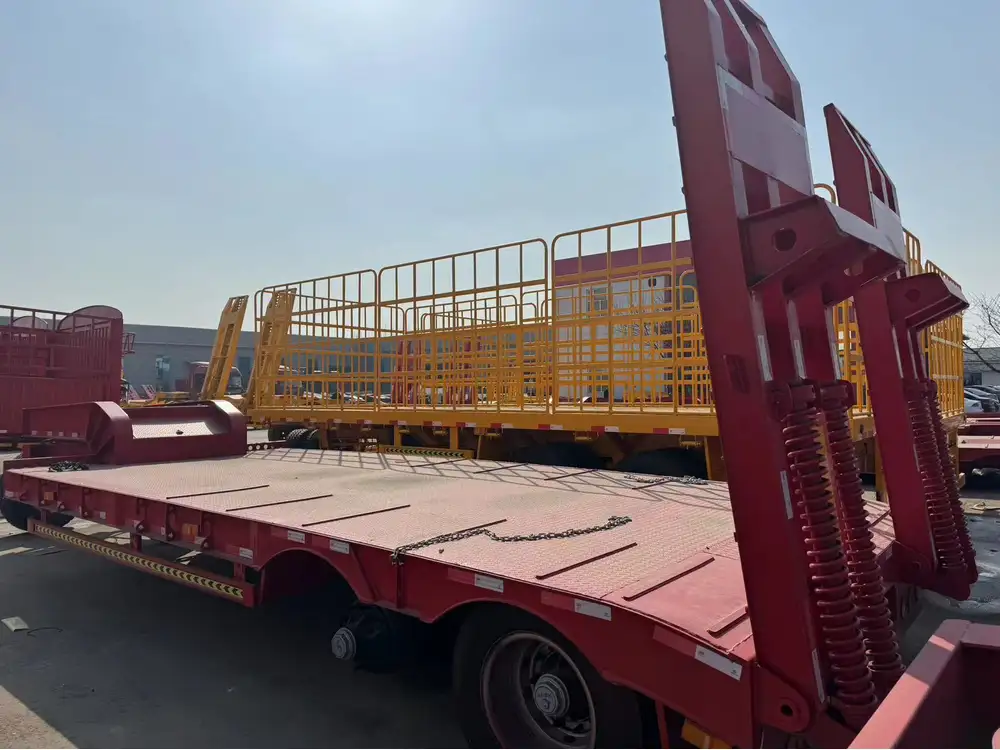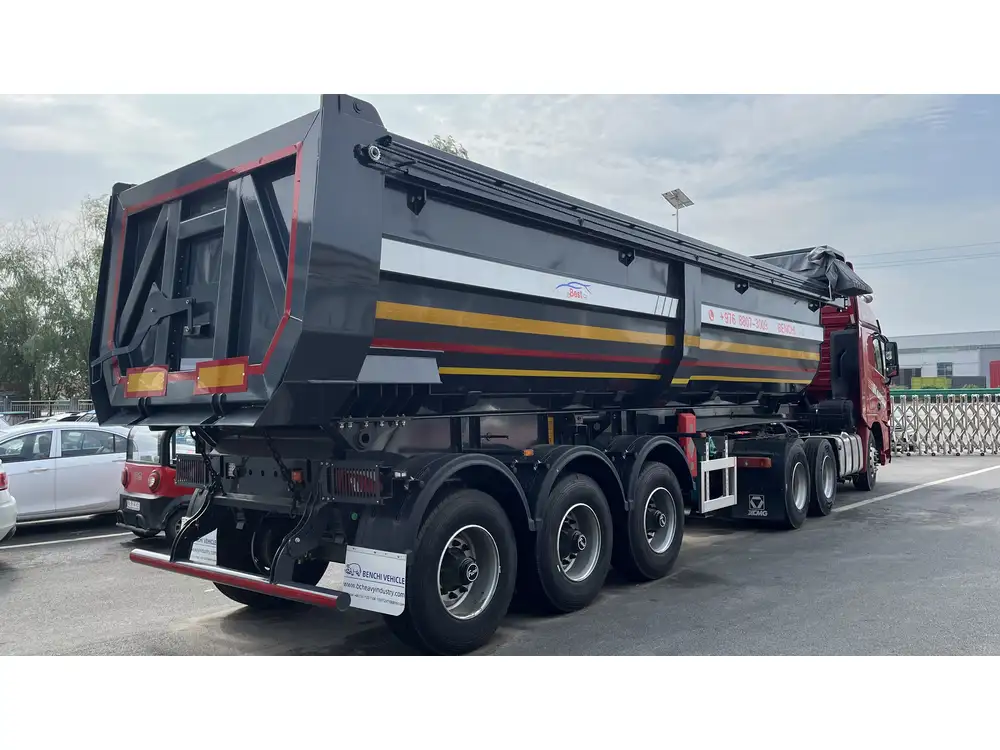When it comes to transporting bulk materials, professionals in the construction and landscaping industries frequently turn to tandem axle dump trailers. These trailers offer significant advantages due to their robust construction and enhanced load capacity. However, a common query that arises is, “How much weight can a tandem axle dump trailer haul?” This article delves deeply into the nuances affecting the load capacity of these trailers, presenting structured insights that will address various user concerns.
What is a Tandem Axle Dump Trailer?
A tandem axle dump trailer is a specialized vehicle designed for hauling heavy loads. Identified by its two axles, this trailer type is engineered to evenly distribute weight, providing stability and maximizing towing capacity. The design is particularly beneficial for transporting materials like gravel, sand, or debris.
Key Components of a Tandem Axle Dump Trailer
| Component | Description |
|---|---|
| Main Frame | Made of high-strength steel, ensuring durability and resistance to bending under load. |
| Axles | Two axles provide increased weight distribution and stability; they are strategically positioned. |
| Bed | The dump bed, available in various lengths and widths, is crucial for accommodating different load sizes. |
| Hydraulic System | Facilitates the dumping mechanism, allowing for efficient unloading of materials. |
| Wheels and Tires | Heavy-duty tires suitable for rugged terrain are essential for optimal performance. |

Load Capacity Factors
The load capacity of a tandem axle dump trailer doesn’t follow a one-size-fits-all principle; various factors play a crucial role. Understanding these components is fundamental to determining how much weight your trailer can realistically haul.
1. Trailer Specifications
The manufacturer typically specifies the maximum weight a tandem axle dump trailer can carry, often referred to as the Gross Vehicle Weight Rating (GVWR).
- Typical GVWR: The GVWR for tandem axle dump trailers generally ranges between 10,000 to 20,000 pounds. However, this can vary based on the manufacturer and model.
- Net Carrying Capacity: To calculate the net carrying capacity, subtract the trailer’s own weight (known as the empty weight or tare weight) from its GVWR.
2. Axle Configurations
The configuration and rating of the axles can greatly impact load capacity.
- Standard Axle Load: Each axle can typically handle around 7,000 to 10,000 pounds. Therefore, two axles can generally bear a combined weight of 14,000 to 20,000 pounds, factoring in safety margins.
| Axle Type | Weight Capacity |
|---|---|
| Single Axle | Up to 7,000 lbs |
| Tandem Axle | Up to 14,000 – 20,000 lbs |

3. Weight Distribution
Proper weight distribution is vital for maintaining balance while transporting loads, which in turn affects load capacity.
- Center of Gravity: Keeping the load as low as possible reduces the risk of tipping. An uneven load can result in structural strain on the trailer and can exceed weight ratings on one axle.
- Loading Techniques: Utilize proper loading techniques, such as placing heavy materials over the axles and avoiding overhanging loads, to maintain balance.
4. Tire Quality and Inflation
The tire’s quality, size, and inflation levels significantly influence the effective weight capacity of the trailer.
- Tire Rating: Each tire will have a Load Range rating that indicates the maximum weight it can support. Check the tire specifications and choose heavy-duty tires designed for hauling.
- Inflation Levels: Under-inflated tires can lead to poor performance and can increase the risk of tire blowouts under heavy loads.
Calculating the Maximum Load
To make an informed decision regarding how much weight you can safely haul with your tandem axle dump trailer, follow these steps:
- Identify the GVWR: Refer to the manufacturer’s documentation for the specific GVWR of your trailer.
- Determine Trailer Weight: Obtain the tare weight of your dump trailer.
Use the Equation:
[ \text{Maximum Load Capacity} = \text{GVWR} – \text{Tare Weight} ]

Example Calculation
- GVWR: 14,000 lbs
- Tare Weight: 3,000 lbs
Thus, this tandem axle dump trailer can safely haul up to 11,000 pounds of material.
Regulatory Considerations
Understanding weight limits and legal guidelines is essential for safe and compliant transport.
Federal and State Regulations
Keep in mind that federal and state regulations concerning weight limits vary:
- Public Roads: Weight limits on public roads must be adhered to, as exceeding them can result in heavy fines and penalties.
- Permits: In some cases, transporting oversized loads may require special permits.

Common Applications of Tandem Axle Dump Trailers
Tandem axle dump trailers are widely used across various industries, reflecting their versatility and efficiency.
1. Construction Sites
Construction companies rely on tandem axle dump trailers for transporting heavy materials across job sites:
- Materials: Concrete, bricks, and steel beams can be efficiently moved.
- Earthworks: Facilitates the removal and relocation of soil and debris.
2. Agricultural Use
For agricultural applications, these trailers serve to haul feed, fertilizer, and landscaping materials. Their capacity makes them ideal for large-scale farming operations.

3. Landscaping
In landscaping projects, tandem axle dump trailers transport bulk materials such as soil, mulch, and stone, enabling efficient workflow for landscapers.
Maintenance Tips for Optimal Performance
To maximize the lifespan and performance of tandem axle dump trailers, regular maintenance is paramount.
1. Regular Inspections
Conduct routine checks on the following components:
- Tires: Ensure they are inflated to the appropriate range, and inspect for wear and tear.
- Hydraulic System: Check for leaks and ensure proper fluid levels for optimal dumping performance.
- Brakes and Lights: Regularly inspect brake function and lighting to ensure safety during transport.

2. Cleaning and Protecting Your Trailer
Regular cleaning removes dirt and debris that could cause corrosion, while protective coatings can prevent rust damage.
3. Overloading Awareness
Always adhere to specified weight limits to avoid structural damage and enhance safety on the road.
Conclusion
The capacity of a tandem axle dump trailer to haul weight hinges on a variety of intricate factors, from its design to regulatory compliance. Understanding how to calculate optimal load limits while considering weight distribution and maintenance will empower you to maximize efficiency and safety in your hauling operations.
Armed with this comprehensive understanding, you can make informed decisions that contribute to enhanced productivity and safety in your industry, whether it be construction, agriculture, or landscaping. Always prioritize adherence to guidelines and regulations, and ensure your operations run smoothly and efficiently.



